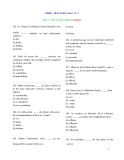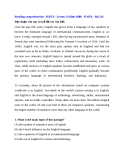
Reading comprehension -TOEFL- Lesson 20 (Đ c hi u -TOEFL- Bài 20)ọ ể
Đ c đo n văn sau và tr l i các câu h i:ọ ạ ả ờ ỏ
It's hard to find artifacts that are genuinely American, but the present day banjo
may be one of them. Even though its ancestry is African, the modern banjo is
nothing like the early instruments first brought by Africans to the southern
plantations. In the nineteenth century 5 the banjo was a standard instrument in
minstrel shows, and, as it continued to be used, it was changed in various ways.
Machined pegs were added for precise tuning, frets were added for better
intonation, and vellum heads were added to improve the tension. The number of
strings also continued to change. Early banjos had four strings, 10 while later
models had as many as nine. In the late 1800s, the five-string banjo was developed,
a model that had a small unfretted drone string that was played with the thumb.
This was the instrument that country singer Earl Scruggs played, and was the type
used to produce that great style of music known as American bluegrass.
15 In the 1920s, the four-string tenor banjo made a remarkable comeback, as banjo
bands became popular in schools and clubs from coast to coast. Again in the 1960s
there was a renewed interest in folk and country music that brought the banjo back
into the forefront of American 20 music. It's an American instrument that continues
to live on.
1. What does this passage mainly discuss?
(A) the lasting effects of bluegrass music
(B) the development of an American instrument
(C) the life of a banjo
(D) changes in music in the nineteenth and twentieth centuries

2. The banjo originally came from
(A) southern plantations
(B) folk and country music
(C) minstrel shows
(D) Africa
3. The word "plantations" in line 4 most probably refers to
(A) types of farms in the South
(B) southern states
(C) southern musical theaters
(D) bands common in the South
4. Which of the following words is most similar to the word "pegs" in line 6?
(A) holes
(B) bars
(C) pins
(D) strings
5. The word "precise" in line 7 could best be replaced by which of the
following?
(A) accurate
(B) confirmed
(C) processed
(D) forthcoming
6. According to the passage, all of the following are true of the five-string
banjo EXCEPT:
(A) It was used by Earl Scruggs.
(B) It was famous in the production of bluegrass music.
(C) It had an unfretted string.
(D) It was a tenor banjo.

7. Which of the following is most similar to the meaning of "comeback" in line
16?
(A) performance
(B) reappearance
(C) gain
(D) achievement
8. The word "renewed" in line 18 could be best replaced by which of the
following?
(A) rescued
(B) remarkable
(C) revived
(D) renowned
9. Which of the following means most nearly the same as the word "forefront"
as used in line 19?
(A) forcast
(B) spotlight
(C) footnote
(D) record
10. Which of the following best indicates the author's attitude toward the
banjo?
(A) It is a unique instrument.
(B) It should be in a museum.
(C) It should be used more.
(D) It must be kept alive.













![Tài liệu luyện thi TOEIC cấp tốc trong 10 ngày [chuẩn nhất]](https://cdn.tailieu.vn/images/document/thumbnail/2025/20251029/kimphuong1001/135x160/99661761725822.jpg)
![Tài liệu Phá đảo TOEIC 900+ từ mất gốc trong 30 ngày [Mới nhất]](https://cdn.tailieu.vn/images/document/thumbnail/2025/20251029/kimphuong1001/135x160/2101761720956.jpg)











